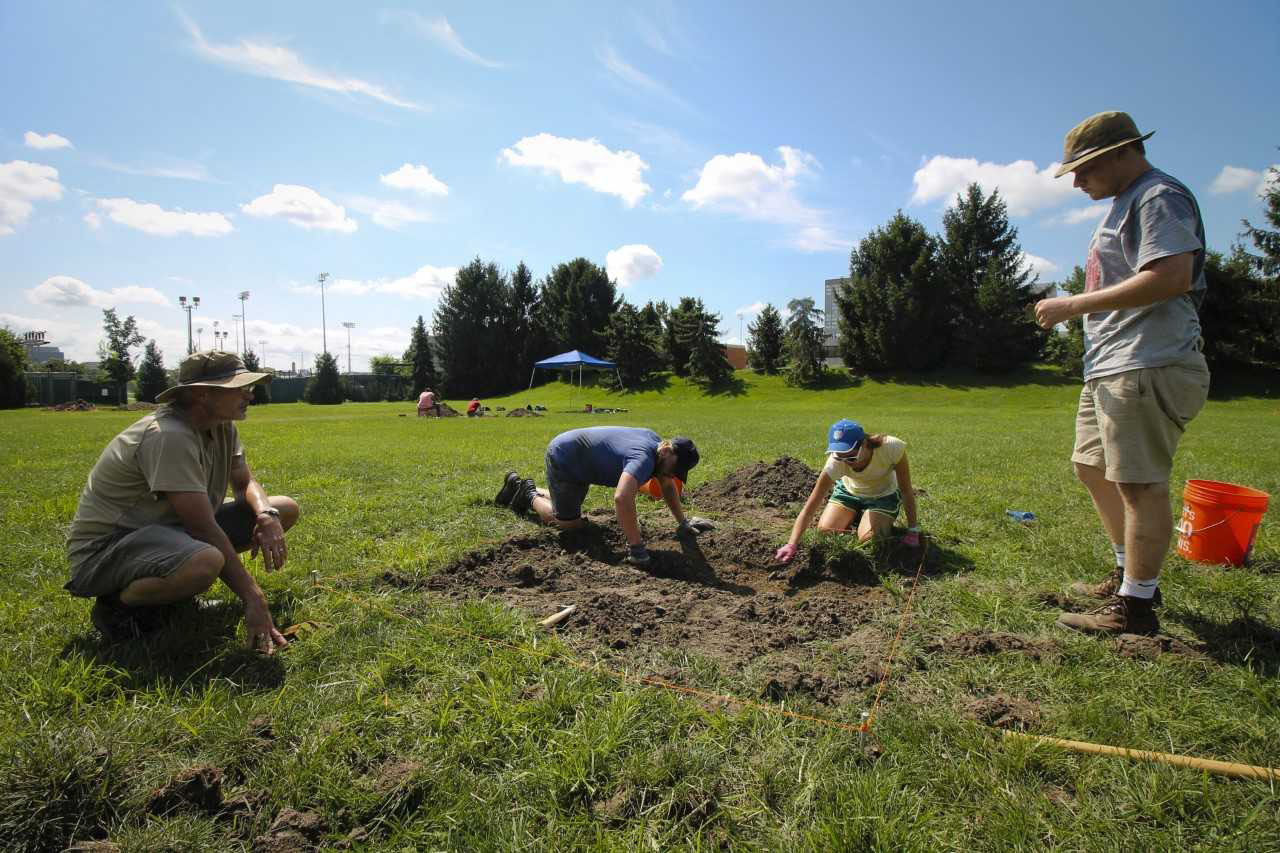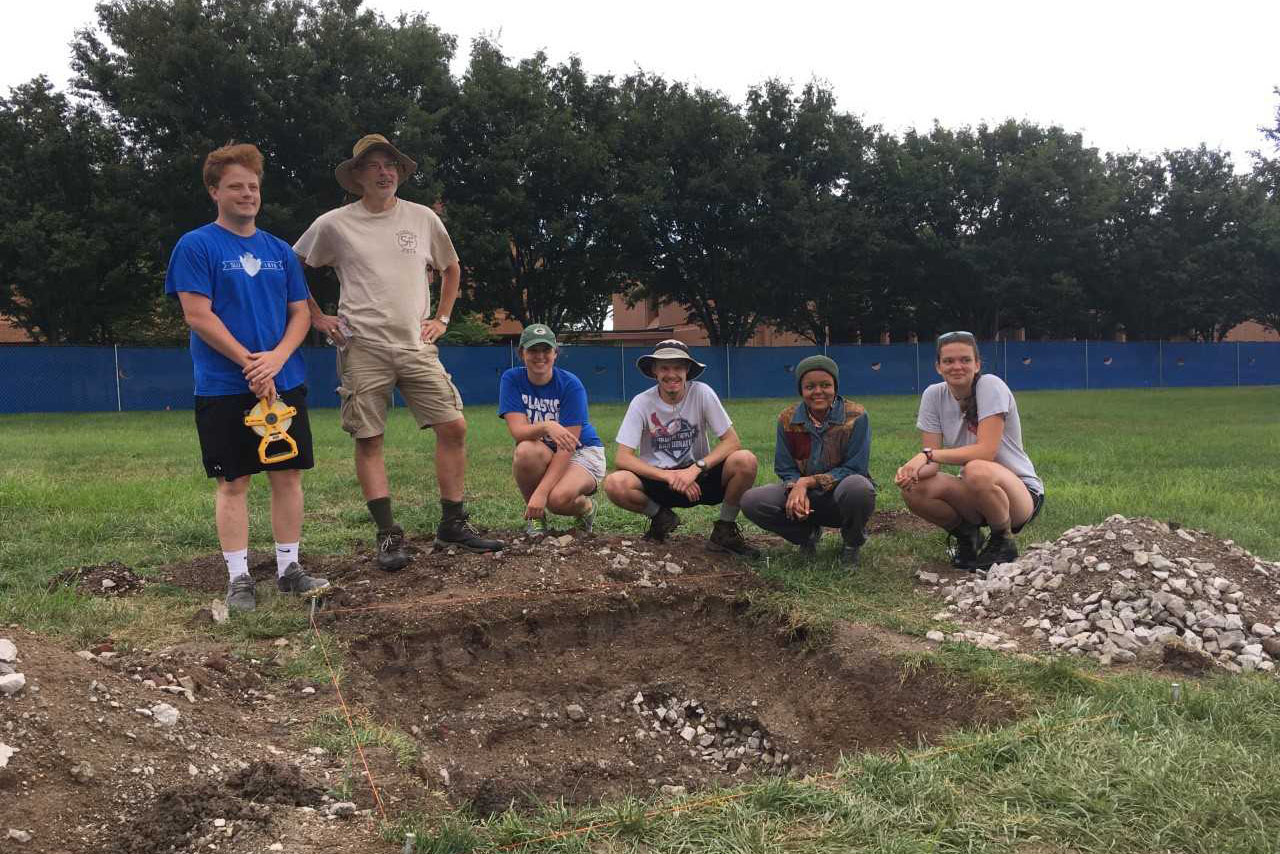Digging Up the Past in SLU’s Backyard
Carrie Bebermeyer
Public Relations Director
carrie.bebermeyer@slu.edu
314-977-8015
Reserved for members of the media.
10/04/2018
When Saint Louis University announced that it would soon begin construction on a $50 million Interdisciplinary Science and Engineering Building, just south of the corner of Lindell and Grand, archeologist Thomas Finan, Ph.D., and his students started digging.
The site where SLU students will attend lectures and conduct experiments in the near future has a past, and Finan and his team wanted to see if they could unearth any clues about the people who lived in this section of St. Louis long before it was part of the University.
“This particular field is one of the last big green spaces on the Saint Louis University campus,” said Finan, who is associate professor of history at SLU. “And for a number of years, I’ve used this field as a test pit for archeological survey and other professors on campus have used it for geological survey.
“But the real draw and attraction to this field is that we know that at the outset of the Civil War this area was an encampment by the Missouri militia -- about 800 Confederates. And, at that particular time, they were on their way to the St. Louis Arsenal, perhaps to capture weapons. The men camped here for about a month, at which time Union forces led by Captain Nathaniel Lyon came in and arrested them. They marched the militia down Lindell and Olive toward the Arsenal and a big riot broke out. People were shot and killed. This was a big fiasco that got a lot of attention in the national press.
“So in one sense we’re here because of that particular event, which is known as the Camp Jackson Affair.”
“But on the other hand, from about 1860 to 1950 this was a thriving neighborhood. We know from work my students have done over the years that this was a very densely occupied residential neighborhood with houses right next to each other lining this whole area. This gives us a lot of information about a short window when we could see a lot of demographic and urban change.
“Plus, it’s a good excuse to dig a hole in the ground with our students,” said Finan, who admits to digging holes in his backyard from the time he was a child, to his parents’ dismay.
For junior Kirsten Buckner, the dig was her first archeology field experience.
“The overall experience was wonderful,” Buckner said. “I feel like I got a chance to learn more about SLU’s history. I’ve lived in St. Louis all of my life but had no clue this was here. When I received the email from Dr. Finan requesting volunteers, I knew it was something I wanted to do.
“However, I was nervous because I had no prior experience with excavating. Dr. Finan told me that I would learn and develop skills on how to excavate.”
“This experience has consolidated my love for history and I know that I am on the right track... I realized that excavating is more than just digging holes, it’s researching, surveying, coming up with ideas, implementing those ideas, and having a positive mindset on what could be discovered."
Kirsten Buckner, junior at SLU
Before they began to dig, the team used a number of different technologies to gather as much information as possible about what lay under the surface of the green field. Vasit Sagan, Ph.D., associate professor of Earth and Atmospheric Sciences, and colleagues conducted drone flyovers in order to produce 3D models of the area and utilized multi-spectral cameras to detect soil chemistry.
Through a special summer research grant at SLU, the archeologists purchased a Frobisher Magnetic Gradiometer to round out their suite of archaeological geophysical exploration tools. A gradiometer measures the fluctuations in the magnetic field in a given space, and then allows researchers to make a map of the variance. It is good for locating ditches, pits, and some buildings, Finan says.
Information from the gradiometer was paired with a resistivity survey to zero in on the most promising areas for digging.
With this information as a guide, Finan and his students began digging in four areas. The team’s excavation led through topsoil, and then clay topsoil, and then to a layer of compacted brick, stone and mortar. Alternating days of rain and heat meant delays and three sites were halted relatively quickly when they hit a parking lot.
In the remaining site, the team found a ceramic marble, bits of blue glass and china, most likely remnants from the residential households that lived in the area, the smallest of traces that people had been here before. There was no evidence, however, of the Missouri militia.
Finan balanced realism with hope, noting that a find from the Civil War era would have been remarkable.
“I didn’t have much hope that we’d find something from the Civil War. That would have been really exciting if we had. The thing I keep thinking in the back of my mind is that if you have 800 people living in a space for three or four weeks, they’re going to leave something. But, the other fact is that this used to be a parking lot, from around 1960 to 1980. We found the parking lot, and underneath, we’ve found a few things.
“We’ve found a bit of a fire pit. That’s often where we find a lot of rubbish. Before the modern era, people used to burn trash in their backyard. The bits of blue glass and china fit that idea.”
For many students, it was their first archeological dig. Many noted the hard work involved, labor that came with blisters after the first day.
Sophomore Matthew Blankley hopes the dig is the beginning of a career in archeology.
“I went into this dig with the intention to go on to become an archaeologist, and that hasn't changed, even if we didn't find anything of huge importance,” Blankley said. “I intend on taking part in the field school that Dr. Vermilion of the Anthropology Department runs out at Cahokia
Mounds this summer, and I hope to work with Dr. Finan again the summer after that at his dig in Ireland. I hope that this will be the first of many digs that I participate in, and hope to someday run my own digs, perhaps somewhere in Wales or England.”
The experience led the team to reflect on history and the lives of those who lived here years before.
“The SLU community should know that people lived all around here and that what they
left behind might be under just a few feet of dirt- just like much of the rest of
the city,” Blankley said.
Buckner agrees, and thinks there are lessons in the experience.
“I think the members of the SLU community should know that SLU has a history that predates the 21st century,” Buckner said. “Parts of SLU were built on territory that served different purposes throughout time. It was used as a Confederate encampment site; later, houses were built in that area. Now, a new science and engineering facility will be built. Also, I think the community should know that when they walk across campus, they are walking on parts of history. I find this to be enlightening. It shows how the history of SLU came to be.
“Even though the project is over, I still remember everything I learned regarding the history of that area,” Buckner said. “Every time I’m on that side of campus, I think about all of the information Dr. Finan shared with our team regarding the history of the Camp Jackson site and how it went through different changes throughout history.”
Though this dig offered a unique opportunity for the team, it is not the only chance Finan has had to explore SLU’s grounds.
“I do digs all over campus,” Finan said. “It’s a problem I have. I find it really fascinating as a native St. Louisan because of the way that the city has changed, and the way you can see the change in the landscape.
“Whenever building and grounds staff have to repair a pipe, I like to look around, and lo and behold we often find something. I’ve done excavations with students near Laclede where we have found heavy deposits of 19th century china and medicine bottles.
Though the dig is over, work to piece together the history of the people who lived here continues.
“The other aspect is that even when we’re not digging we can connect what we find to historical sources, like census records, aerial photographs, fire insurance maps from 1900s. We put all of that together,” Finan said. “The other thing about Saint Louis University, is that because we’ve had a school of aviation for a long time, we have a lot of great aerial photos of campus. The Saint Louis University archives has a great collection.”
For the students involved in the dig, the experiential learning opportunity has solidified their interest in archeology and history.
“What’s next for me? I have so many plans.” Buckner said. “Mainly, I plan to continue my education here at SLU. I would love to go with Dr. Finan and his excavation team to Ireland before I graduate.
“This experience has consolidated my love for history and I know that I am on the right track. Also, I have developed more love for archaeologists because the work they do isn’t easy. I realized that excavating is more than just digging holes, it’s researching, surveying, coming up with ideas, implementing those ideas, and having a positive mindset on what could be discovered.
“Sometimes, nothing will be found, but you keep persevering,” Buckner said. “I would love to be a part of another excavation. I was very fortunate to be a part of a team that loves learning, working, and helping each other when they could.”
As for Finan, hope springs eternal. He says he imagines he’ll show up from time to time while the bulldozers are here. As he says, “You never know what you may find.”
Founded in 1818, Saint Louis University is one of the nation’s oldest and most prestigious Catholic institutions. Rooted in Jesuit values and its pioneering history as the first university west of the Mississippi River, SLU offers nearly 13,000 students a rigorous, transformative education of the whole person. At the core of the University’s diverse community of scholars is SLU’s service-focused mission, which challenges.

